#500BCE
Explore tagged Tumblr posts
Photo
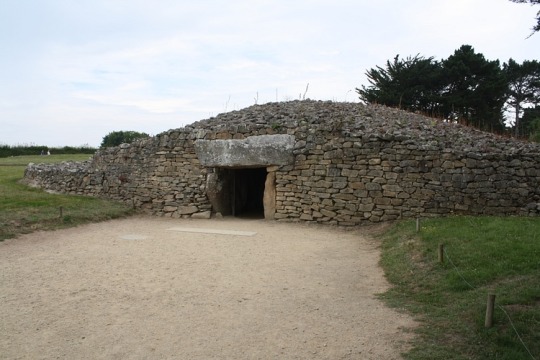
Locmariaquer
Locmariaquer is a Stone Age site in north-west France distinguished by its two large stone tombs and massive granite standing stone or menhir. The monumental structures, all built within metres of each other, were built in the 5th millennium BCE by the local sedentary farming community and are amongst the most impressive Neolithic monuments anywhere.
Grand-Menhir
The huge igneous stone monolith known as the Grand-Menhir was a single piece of granite 20 metres tall and over 280 tonnes in weight. The engineering skills employed to move and erect such a massive stone are impressive, especially as the nearest source of such stone was 10 km distant. The menhir was carefully positioned, probably using earth ramps, at the end of an alignment of 18 interlocking stones c. 4,500 BCE, now destroyed but indicated at the site today. The menhir would have been finished off and given a smooth surface using quartz hammers. Another large menhir or stele once stood near the Grand-Menhir and two large pieces from it - identified by their ox carvings - were reused in the Table-des-Marchands tomb (tumulus) nearby (see below) and the stone tomb on the small island of Gavrinis across the Gulf of Morbihan 4 km away. The surface of the Grand-Menhir shows deliberate stud marks and a socket was made in the base of the stone to increase its stability when standing. Nevertheless, the giant subsequently toppled over and fractured into four large pieces. Whether this was due to natural causes such as high winds, lightning or an earthquake, or due to a deliberate breakage is unclear. More certain is the fall likely occurred only a few hundred years after its erection, sometime around 4,000 BCE.
Continue reading...
40 notes
·
View notes
Text

apparently nothing has actually changed through the years about trying to guess people's genders. mnesilochus, squinting at agathon: i have no idea what your deal is
#why is this actually still how people are!!!! “youre dressed one way but look another way. what is happening??” get a hobby!#agathon#tagamemnon#i need to summon an army interested in niche 500bce genderqueer tragic poets... come to me
44 notes
·
View notes
Text
Tyne-nny Reborn

Took me literal weeks. I don't even remember how much.
Lore under the cut
Tyne-nny (chukchi name) is an inuit kindred that recently awoke after being frozen in ice for a very, very long time. She is part of the Dorset culture that was estimated to be active from 500BCE to 1500CE.
I don't have much more for them right now. I'm still learning about modern inuit culture and especially inuit mythology to tie them into her story.
25 notes
·
View notes
Text
Imagine Kratos discovers it's your Birthday...
Kratos finds out when your birthday is. He has fond memories of celebrating birthdays and other holidays as a child. It was perhaps the only time he was surrounded by joy and he had a break from spartan training.
You told Kratos to not make a big deal about your birthday. All you wanted was to spend time with him, Atreus and your friends, and share a meal together.
However, Kratos’ Greek hospitality and love for you would not allow him to settle for a small celebration.
The weeks leading up to your birthday, he’d keep an eye out on his excursions to find gifts for you. Any artifacts, jewelry, or pottery he thought you would like got scooped up and taken back home.
He would also go out of his way to gather any supplies and ingredients he needed to give you a proper celebration.
One month before your birthday, Kratos had gotten some grapes, honey, and spices to make up a bottle of wine so it would be ready just in time for your birthday.
The night before your birthday he would sneak out of bed to bake you a classic honey cake, as tradition from his homeland. He would add something extra to make it special, maybe some nuts, fruit, or wine. Whatever he thought you would like the best.
The morning of your birthday Kratos would enter the room the two of you shared, holding a cake with as many candles as years you’ve been alive, plus one.
Kratos would tell you, “Χρόνια Πολλά, Ό,τι επιθυμείς” meaning Happy Birthday; that he wishes you many more years to celebrate, and that all your hopes and desires come true.
You would thank him and blow out your candles, wishing for every birthday to start out this way.
---
A/N: It’s my birthday today, so I did some online digging about how long birthdays have been celebrated and if the ancient greeks celebrated birthdays. I found out they probably would have, at least around the time Kratos was growing up, somewhere in early 500BCE. This is all just random internet searches, not meant to be taken too seriously of course. I found that they may have started to celebrate mortals birthdays (not just gods) at least around 200BCE. They would bake cakes in the shape of the moon and but candles on it and light them so it shone like the moon as well. This was used as an offer to the goddess Artemis, the goddess of childbirth. Apparently the Greeks were always known to throw good parties with lots of gifts, wine and cake, so let’s turn up.
#god of war#god of war ragnorak#gow#gowr#kratos x reader#atreus#kratos#kratos x gn reader#gow fanfic#god of war fanfic#god of war fanfiction#god of war kratos#gow imagine#kratos imagine#gowr imagine#god of war imagine#god of war ragnarok imagine#gow birthday#god of war birthday#happy birthday#birthday
277 notes
·
View notes
Text
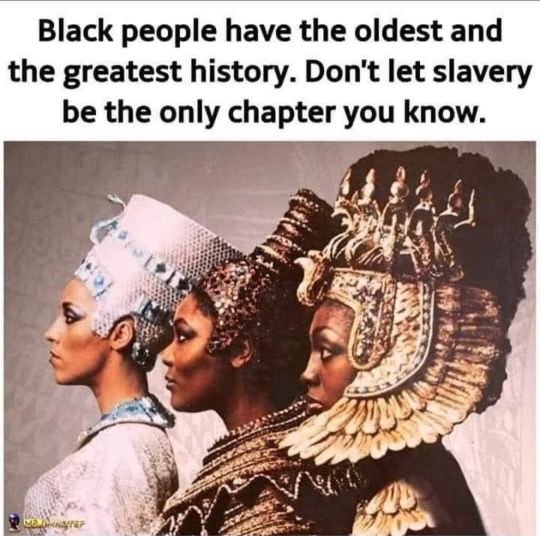
Study your REAL HIST0RY.
Kemet (Northeast Africa)
3100 B.C. to 332 B.C. (2,700 YEARS)
Kingdom of Kush (West Africa)
1069 BCE - 400 CE (1400 YEARS)
Moroccan Empire (Northwest Africa)
788 -1957 (1169 YEARS)
Aksumite Empire (East Africa)
100 to 940 CE (940 YEARS)
Empire of Ghana (West Africa)
300 - 1235 CE. (935 YEARS)
Moorish Empire (N. Africa & Spain)
711 C.E. - 1492 C.E. (781 YEARS)
Ethiopian Empire (East Africa)
1270 -1974 (700 YEARS)
Ile-Ife Empire (West Africa)
500BCE
Benin Kingdom (West Africa)
1200s - 1800s (600 YEARS)
Ancient Carthage (North Africa)
c. 650 BCE - 146 BCE.(504 YEARS)
Mali Empire (West Africa)
1226-1670 (444 YEARS)
Hausaland Empire (West Africa)
1500 - 1800 (300 YEARS)
Kingdom of Zimbabwe (Southeast Africa)
1220-1450 CE (230 YEARS)
AFRICANS HAVE RULED AS KINGS FOR OVER 11,000 COLLECTIVE YEARS!!
20 notes
·
View notes
Text
I think it’s funny that most people’s images of museum archives and working with ancient artifacts is like, gloved hands and tongs very carefully moving objects like they’ll break at any second when in my experience working in an archive has mostly just consisted of manhandling objects from 500BCE in my bare hands and miming baseball throws every time the people in charge aren’t watching
#if my post abt wanting to throw the aryballos gets 1k notes before the end of the trip I’ll buy a replica and actually throw one#<- mostly not serious bc I cannot foresee that actually happening but. idk I’ll keep my word if it does#💫
4 notes
·
View notes
Text
"just let my hair down after a fun night out" remains the hottest look since probably 500BCE
2 notes
·
View notes
Photo
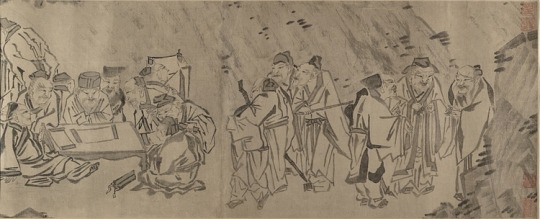
Teng Shih
Teng Shih (l. c. 500 BCE) was a Chinese Sophist and lawyer who lived and wrote in the province of Cheng (Pengcheng, modern-day Xuzhou, Jiangsu province) during the era of the Spring and Autumn Period (c. 772-476 BCE) which preceded the Warring States Period (c. 481-221 BCE) in China.
He is associated with the informal school of Relativism which maintained that any declaration of 'truth' was relative to the individual and is best known for teaching 'the doctrines of the relativity of right and wrong'. He is also famous for his persistent opposition to the government of Tse-Tsan (d. 522 BCE), the magistrate of Cheng who disapproved of his philosophy, and his clever methods of expressing his dissent.
The period in which he lived was a chaotic time during which the waning power of the Zhou Dynasty (1046-256 BCE) resulted in seven states – which had already absorbed many other smaller ones – fighting each other for control of China. This period gave rise to the Hundred Schools of Thought, a figurative phrase referencing many different schools of Chinese philosophy established at this time, largely, in response to the disorder and instability caused by the wars. Among the many, 14 were considered most notable by later Chinese historians:
Confucianism
Taoism
Legalism
Mohism
School of Names
Yin-Yang School
School of Minor Talks
School of Diplomacy
Agriculturalism
Syncretism
Yangism (Hedonist School)
Relativism
School of the Military
School of Medicine
Some of these, such as Confucianism and Mohism, were formal schools but many, such as Teng Shih's, were not; they were, rather 'schools of thought' promoted by a founder and a few followers. Teng Shih may have influenced The School of Names, established in the 3rd century BCE (also known as the School of the Logicians), but was definitely associated with the school of Relativism.
This philosophy was considered subversive by Tse-Tsan (about whom almost nothing else is known) who, after repeated conflicts with Teng Shih, had him executed shortly before his own death in 522 BCE (though this may have occurred under Tse-Tsan's successor). Teng Shih's works were largely destroyed by the Qin Dynasty (221-206 BCE) which rose to power at the conclusion of the Warring States Period. His philosophy, and the few details of his life still extant, were preserved in Confucian works which were hostile to him. In the present day, he is most often referenced as a Chinese counterpart to the Greek relativist Protagoras of Abdera (l. 485-415 BCE) with whom his philosophy accords closely.
The Hundred Schools of Thought & Relativism
The Zhou Dynasty had been a decentralized state which established a vast territory by allowing lords, loyal to the king, to found their own separate, and almost autonomous, kingdoms, which paid taxes and supplied armies to the king. Although this policy worked well at first, and the Zhou prospered at every level, in time the kingdoms grew to form their own states which became more powerful than the king. Around 771 BCE, the Zhou were forced to move their capital east in response to barbarian invasions from the west, and this begins the era known as the Eastern Zhou Period (c. 772-256 BCE), which corresponds to the Spring and Autumn Period and the Warring States Period when the seven separate states which had now absorbed the many weaker ones fought amongst themselves for supremacy.
The Zhou were too weak to do anything about the conflict and, as its authority weakened, so did the bureaucratic administration it had established. Scholars, teachers, and philosophers who were previously employed by the state lost their positions and so founded their own schools to develop their own philosophies. This movement is known as the Hundred Schools of Thought (meaning “many”, not a literal count of 100), which produced some of the most influential philosophies in Chinese and world history.
Although it is unknown how Teng Shih's relativism developed, it was most likely in response to the many different solutions being proposed by these schools in rectifying the conflict of the era. Each school claimed to have the best solution to reforming government policy, helping the lower classes, ending the wars, and establishing peace and, at the same time, discredited the others in elevating their own. The solutions offered by each of the schools were self-evidently true to them while simultaneously seen as lacking by the others.
In this climate, the conclusion that no claim to truth could be objectively proven, and that any 'truth' was only 'true' to the claimant of that truth, would be a rational response. Teng Shih would have agreed with Protagoras' famous statement usually paraphrased as “a man is the measure of all things” meaning truth is relative to each individual. Without an objective standard of truth on which all can agree, any claim to truth – especially regarding philosophical matters - must be subjective.
Continue reading...
27 notes
·
View notes
Text
Devastating news I can’t study art from the 1900’s and the 0-500bce’s I must find some way to choose a concentration… phooey
1 note
·
View note
Text
Art Studio 2 Research: Potential inspiration for the additional sculptures
Jane Gavan and Jacky Redgate's feedback on Organic Space: "Well done, superb sound work! The visual imagery was poetic - theoretical underpinnings tremendous and outstanding commitment. A great research project and methodology around the subject of soundscape ecology and engaging with fieldwork and trips. The final chosen looped 3 sequences are still being realised but can be refined in Semester 2. The direction is for shorter experiential 'narrative sequence'. The sounds of the body is the last one yet unrealised. There is a lot to explore and develop how you will install your work for Semester 2, including sculptural possibilities, which wasn't realised yet in Semester 1. Push the sculptural and installation potential of your work. All the best for Semester 2! Jacky and Jane"
My thoughts from the feedback:
What about sculptures that can be interacted with to 'make sound'? (Perhaps leading the audience into the main exhibition room) - This will be addressed in this post and in future documentation.
Colours and shapes could mirror some of the animated forms/textures in the short film (and maybe other things in nature). - This will also be addressed in this post and in future documentation.
The soundscape in the 'terrestrial segment' of the short film needs to be explored/refined further, as does the overall installation and narrative sequence. - This will be addressed in future documentation.
Huaco Silbador (the Peruvian whistling vessel)
Created by various cultural groups in Peru from 500BCE to the 1500s.
The vessels were modelled after birds, other animals, or people.
Two different types: one that is single-chambered and another that is double-chambered.
You could either blow into it (both single-chambered and double-chambered) or fill it with water and tilt it back and forth (double-chambered). Both actions are demonstrated in the videos and diagrams below.
IDEA 1: Sculptures resembling the appearance of the environments/creatures making the sounds.
IDEA 2: Hollow interior to produce the sound?
youtube
youtube


Row 1: Ceramic whistling bottle - Muscovy (date unknown, AMNH Collection), Whistling bottle depicting maize deity (900-1400CE, National Museum of the American Indian)
Row 2: Double whistling bottle with jaguar figure (100-700CE, National Museum of the American Indian), Double-chambered ceramic whistling vessel - camelid/llama (date unknown, Smithonian National Museum of Natural History)
Row 3: Double-chambered ceramic whistling vessel - macaw with fruit (200BCE-600CE, Museo Larco)
Row 4: Monkey ceramic whistling bottle (200BCE-600CE, Museo Larco)
Row 5: Jaguar Whistling Jar (500-900CE, The Met Collection)
Row 6: Whistling Jar (200BCE-600CE, The Met Collection), Double-bodied ceramic whistling bottle - bat and spondylus shell (date unknown, AMNH Collection)
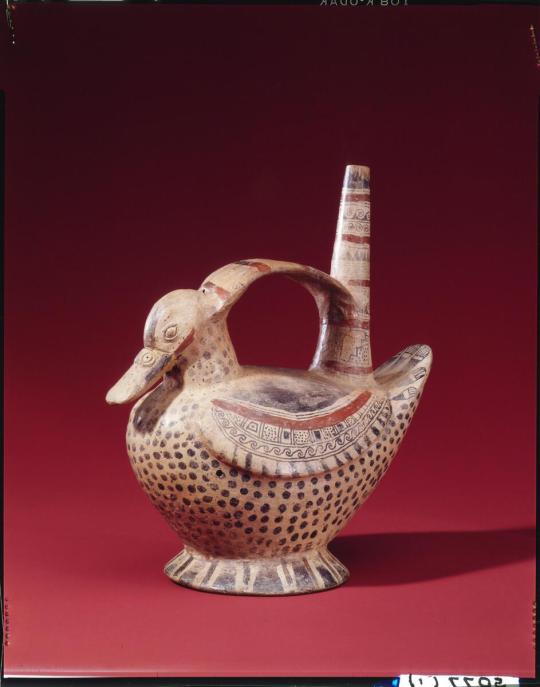

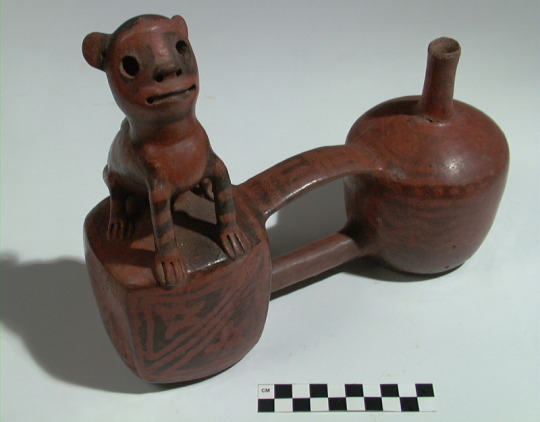




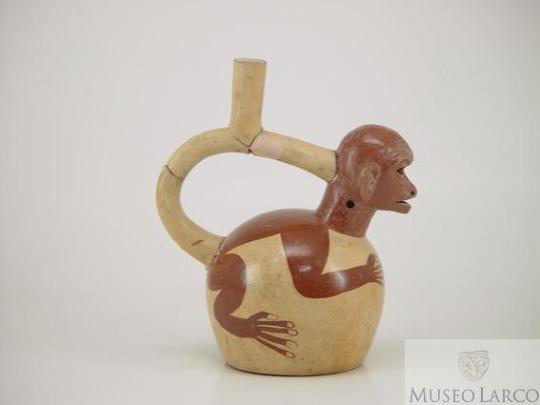
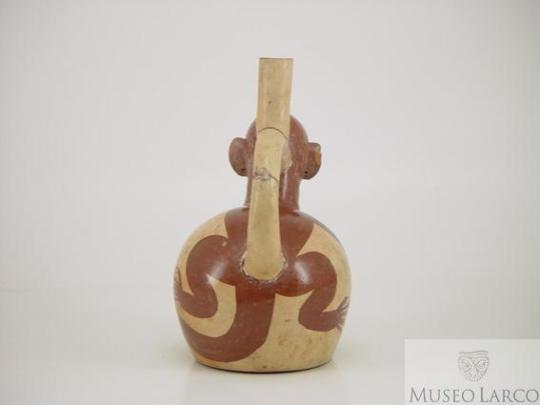

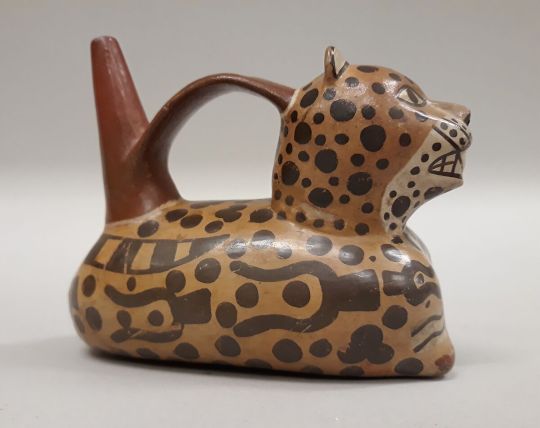


Artist Archive: Healing sound baths in Guadalupe Maravilla's body-of-work exhibition Luz y fuerza (2021)
Exhibition descriptions (from MOMA's website): ""I create new mythologies that take the form of real and fictionalised rituals based on my own lived experiences," says Guadalupe Maravilla. Two events from the artist’s life animate his work most of all: emigrating from his native El Salvador to the United States as an unaccompanied, undocumented eight-year-old and, later, surviving cancer. From this personal history grows a multidisciplinary practice that addresses trauma, contagion, rehabilitation, and rebirth.
This gallery—whose Spanish title translates as "hope and strength"—features works inspired by Mesoamerican myths and Salvadoran traditions. The sculptures are made from natural materials and ready-made objects selected for their therapeutic, historical, symbolic, and aesthetic properties. Maravilla sees them as healing instruments he can activate—and often does, especially for people experiencing illness and other hardships.
Disease Thrower #5 is a sculpture, a shrine, a wearable headdress, and an acoustic instrument. Like all works in the Disease Thrower series, it is, according to the artist, a "healing machine," which can be activated to create a sound bath with curative potential. It is made from both natural materials, such as straw and loofah, and man-made objects that Maravilla collected while retracing parts of the migratory route from El Salvador to the United States he took as a child. The work also includes anatomical models: one of a breast, another of a malignant tumour.
While undergoing treatment for cancer, Maravilla was introduced to sound therapy, a healing practice that uses vibrations produced by instruments. According to the artist, this practice “cleanse[s] the water in our bodies, which can carry stress, impurities, and, in some cases, diseases.” Now a trained sound healer, Maravilla regularly holds therapeutic sound baths for undocumented immigrants, cancer patients, and others in need. The gongs are tuned to specific frequencies intended to resonate with the moon and other planets in our solar system. Over the course of this exhibition, the artist will be regularly activating the sculptures in immersive sound bath sessions that visitors can sign up to attend."
Sound as healing/mediative?
Interaction to produce sound may not be limited to blowing air into hollow objects.
Luz y fuerza (multiple dates, sculptural body of work installation with performance)

Disease Thrower #5 (2019, sculpture - Gong, glass, steel, wood, glue mixture, cotton, wood, plastic, loofah, paint, straw, Florida Water, and objects collected from a ritual retracing the artist's original migration route)







#sca projects#year 3 art studio project 2#aa sca yr 3 sem 2 week 2#aa sca yr 3 sem 2 week 1#sca usyd new contemporaries grad show
0 notes
Text
imagine being the guy who wrote the old testament thinking he'd get the new york times fantasy bestseller of the year 500BCE or whatever and seeing what it did to society millennia later
0 notes
Photo
That second to last one... it's different from the rest and kinda matches the prompt in a better way.










“A cell phone from the 500bc”
Created by DALL·E 2, AI that can create realistic images and art from a description.
Sharing is caring!
Substack: dalle.substack.com
Twitter: @Dalle2AI
The heading of this post was used to generate the image, src
48 notes
·
View notes
Text
Dear all the teachers who said university is oh so serious, I quoted a tumblr post in my ancient history essay, put it in the bibliography and I received a “Nice!” as a comment from my professor. I shit you not.
#public forum#university#ancient history#shitpost#funny#the task was to write about covid like we were in 500BCE#but still
5 notes
·
View notes
Text
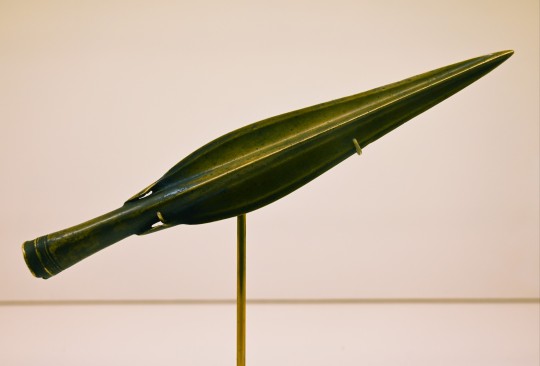
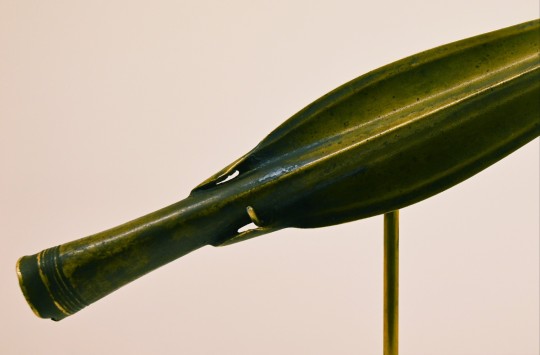
Bronze Age Spearhead from Semerwater, 2499 to 500BCE, The Dales Countryside Museum, Hawes
#ice age#stone age#bronze age#copper age#iron age#neolithic#mesolithic#calcholithic#paleolithic#prehistoric#prehistory#bronze weapons#spearheads#prehistoric weapons#spearhead#metalwork#prehistoric metalwork#archaeology#yorkshire dales#relic#artefact#ancient culture#ancient living#ancient craft
205 notes
·
View notes
Photo
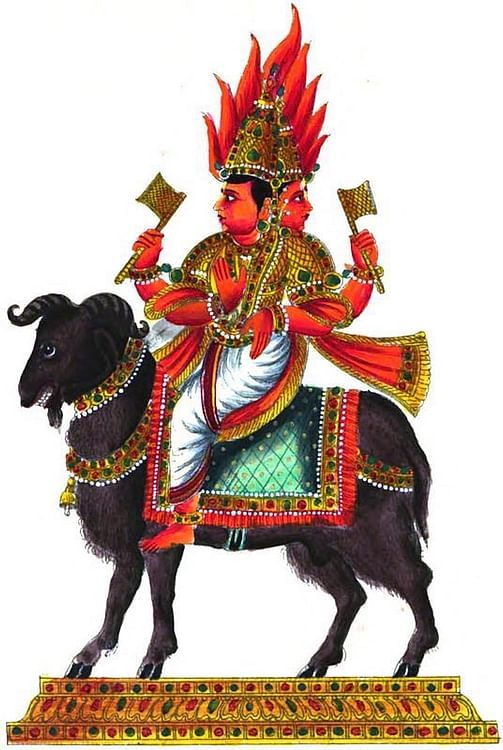
Agni
Agni is the Hindu god of fire. He is regarded as the friend and protector of humanity, in particular, he safeguards the home. Various forms of fire are associated with Agni and include the sun, lightning, comets, sacrificial fire, domestic fires, the fire of the funeral pyre, and the digestive fire which is within all humans. Agni was especially important in the Vedic period (1500-500 BCE), and the Vedas contains more hymns to him than to any other deity. He is still considered today omnipresent though not directly worshipped. Agni knows the thoughts of all people and is a witness to all important actions, hence the use of fire in many important Hindu ceremonies such as marriages. He is also referred to in sacred texts such as the Mahabharata as the 'Oblation-devourer' and the 'Purifier'. With flaming hair and riding a goat, he is easily identified in Hindu art.
Agni's wife is the daughter of King Nila who impressed the fire god by being the only woman in the kingdom who managed to kindle a flame in the royal palace. In some myths, Karttikeya (Skanda), the Hindu god of war, is Agni's son and the result of Agni's conquest of the Pleiades, the wives of the Seven Sages.
Agni & Various Fires
Agni is the son of the Celestial Waters, and that element is closely connected with fire which is thought to be carried down to earth within rain. From there fire is drawn up by vegetation and so when two sticks are rubbed together fire appears. Agni is also responsible for lightning which is born from the god's union with the cloud goddess. Another fire Agni is associated with is the funeral pyre; in this role, he leads the dead to their final judgement by Yama, ruler of the Underworld.
Agni is perhaps most closely associated with sacrificial fires where he is thought to carry the offerings of humans to the gods. According to various myths, Agni was at first afraid to take on this duty as his three brothers had been killed already whilst performing the task. Consequently, Agni hid in the subterranean waters but, unfortunately, fish revealed his hiding place to the gods. As a result, Agni cursed them so that fish would become the easy prey of men. In another version it is frogs, then elephants, and then parrots which reveal Agni's attempts at hiding and the god punished them all by distorting their speech ever after. The final hiding place of Agni in this version was inside a sami tree and so it is considered the sacred abode of fire in Hindu rituals and its sticks are used to make fires. Reluctantly taking up his duty again Agni did negotiate by way of compensation to always receive a share of the sacrifice he carried to the gods and he was given the boon of ever-lasting life.
Agni appears in all forms of fire and even those things which burn well or have a certain lustre. In the Brhaddevata we are told that at one point Agni is dismembered and distributed among earthly things. The god's flesh and fat becomes guggulu resin, his bones the pine tree, his semen becomes gold and silver, his blood and bile are transformed into minerals, his nails are tortoises, entrails the avaka plant, his bone marrow sand and gravel, his sinews become tejana grass, his hair kusa grass, and his body hair becomes kasa grass which was used in sacrificial rituals.
Over time Agni's importance as a god diminishes, a fact explained in the Mahabharata as due to his overindulgence in consuming one too many offerings. In the Visnu Purana he is described as the eldest son of Brahma and Svaha is his wife. Together they had three sons, Pavaka, Pavamana, and Suchi, who in turn had 45 sons, which, including their fathers and grandmother, totals 49, the number of sacred fires in the Vayu Purana.
Agni, according to one Rigveda hymn attributed to the sage Vasistha, also has a darker side. Similar in nature to the 'flesh-eater' demons, the raksasa, he has two wickedly sharp iron tusks and he devours his victims without mercy. However, when called upon by the gods, Agni destroys the raksasa with his flaming spears. This episode, when Agni becomes a servant of the gods, is illustrative of his fall from the pinnacle of the pantheon.
Continue reading...
21 notes
·
View notes
